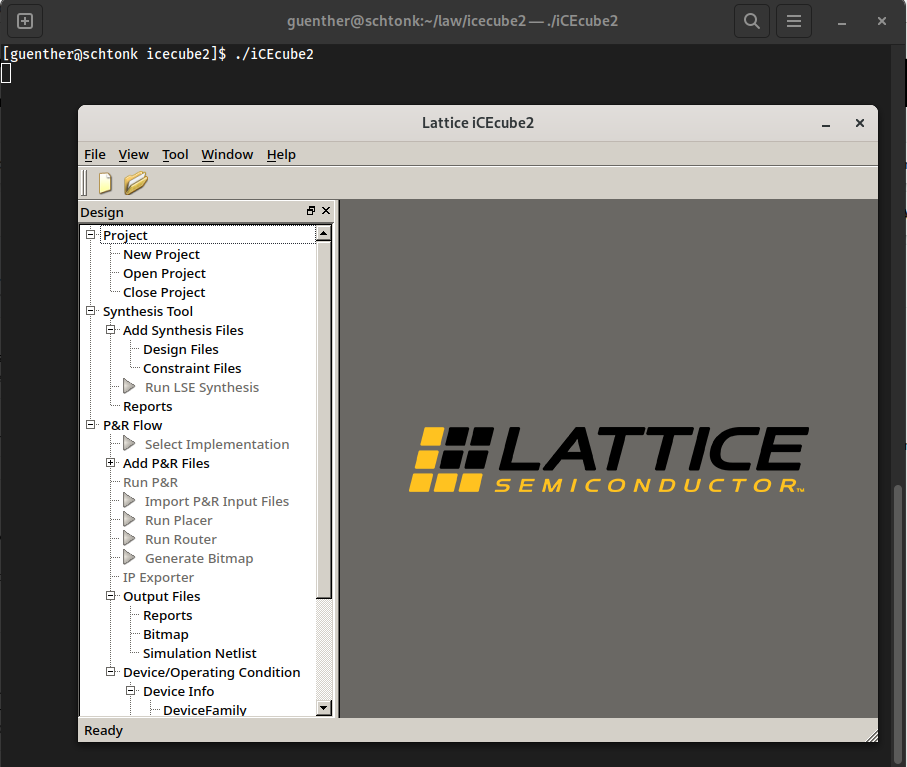Do you have troubles installing iCEcube2 on your Linux computer? Lattice is providing a Linux installation for iCEcube2 here .
Following the installation instruction I ran into following issue:
$ unzip iCEcube2setup_Dec_10_2020_2012_lin.zip Archive: iCEcube2setup_Dec_10_2020_2012_lin.zip inflating: iCEcube2setup_Dec_10_2020_2012
$ chmod +x iCEcube2setup_Dec_10_2020_2012
$ ./iCEcube2setup_Dec_10_2020_2012 bash: ./iCEcube2setup_Dec_10_2020_2012: cannot execute: required file not found
iCEcube2 is a 32 bit executable and very probably you're running a 64 bit Linux. The solution? Install the 32 bit dependencies.
Fedora 
To get iCEcube2 installed on Fedora (tested on Fedora 38):
32bit dependencies 
$ sudo dnf install glibc.i686 libXext.i686 libSM.i686 libXi.i686 libXrender.i686 libXrandr.i686 libXfixes.i686 libXcursor.i686 libXinerama.i686 freetype.i686 libpng12.i686 ... Verifying : libxml2-2.10.4-1.fc38.i686 44/45 Verifying : p11-kit-0.25.0-1.fc38.i686 45/45 Installed: bzip2-libs-1.0.8-13.fc38.i686 cairo-1.17.8-4.fc38.i686 fontconfig-2.14.2-1.fc38.i686 freetype-2.13.0-2.fc38.i686 glib2-2.76.5-2.fc38.i686 glibc-2.37-5.fc38.i686 glibc-gconv-extra-2.37-5.fc38.i686 gmp-1:6.2.1-4.fc38.i686 gnutls-3.8.1-1.fc38.i686 graphite2-1.3.14-11.fc38.i686 harfbuzz-7.1.0-1.fc38.i686 libICE-1.0.10-10.fc38.i686 libSM-1.2.3-12.fc38.i686 libX11-1.8.6-1.fc38.i686 libXau-1.0.11-2.fc38.i686 libXcursor-1.2.1-3.fc38.i686 libXext-1.3.5-2.fc38.i686 libXfixes-6.0.0-5.fc38.i686 libXi-1.8.1-1.fc38.i686 libXinerama-1.1.5-2.fc38.i686 libXrandr-1.5.2-10.fc38.i686 libXrender-0.9.11-2.fc38.i686 libblkid-2.38.1-4.fc38.i686 libbrotli-1.0.9-11.fc38.i686 libffi-3.4.4-2.fc38.i686 libgcc-13.2.1-1.fc38.i686 libidn2-2.3.4-2.fc38.i686 libmount-2.38.1-4.fc38.i686 libpng-2:1.6.37-14.fc38.i686 libpng12-1.2.57-17.fc38.i686 libseLinux-3.5-1.fc38.i686 libsepol-3.5-1.fc38.i686 libstdc++-13.2.1-1.fc38.i686 libtasn1-4.19.0-2.fc38.i686 libunistring-1.1-3.fc38.i686 libunistring1.0-1.0-1.fc38.i686 libuuid-2.38.1-4.fc38.i686 libxcb-1.13.1-11.fc38.i686 libxml2-2.10.4-1.fc38.i686 nettle-3.8-3.fc38.i686 p11-kit-0.25.0-1.fc38.i686 pcre2-10.42-1.fc38.1.i686 pixman-0.42.2-1.fc38.i686 xz-libs-5.4.1-1.fc38.i686 zlib-1.2.13-3.fc38.i686 Complete!
eth0 device 
The license manager is searching for a eth0 device to compare the MAC address. To achieve this, we have to tell the linux kernel while booting.
Add net.ifnames=0 to GRUB_CMLINE_LINUX in the file /etc/default/grub:
GRUB_TIMEOUT=5
GRUB_DISTRIBUTOR="$(sed 's, release .*$,,g' /etc/system-release)"
GRUB_DEFAULT=saved
GRUB_DISABLE_SUBMENU=true
GRUB_TERMINAL_OUTPUT="console"
GRUB_CMDLINE_LINUX="rd.luks.uuid=luks-ff974974-8e99-4833-ab19-af4bd2b0a201 rhgb quiet net.ifnames=0"
GRUB_DISABLE_RECOVERY="true"
GRUB_ENABLE_BLSCFG=true
Now we need to re-build the grub bootloader:
$ grub2-mkconfig -o /boot/grub2/grub.cfg
Now we are ready to reboot.
Install 
Install iCEcube2 by starting the installer:
$ ./iCEcube2setup_Dec_10_2020_2012
Extend library path 
I was still unable to start iCEcube2 and after digging a while, here is the solution. Adding /usr/lib/ to the library path helped. Open the config.xml path in the iCEcube2 installation path and add the path:
<Starter>
<ProductId organizationName="Lattice" organizationDomain="latticesemi.com">iCEcube 2008.6</ProductId>
<Environment>
<LM_LICENSE_FILE append="0" userInput="LM_LICENSE_FILE">/home/guenther/license.dat</LM_LICENSE_FILE>
<SBT_DIR append="0">$(RootPath)/sbt_backend</SBT_DIR>
<LD_LIBRARY_PATH>/usr/lib/:$(RootPath)/sbt_backend/lib/linux/opt:$(RootPath)/sbt_backend/bin/linux/opt/synpwrap:$(RootPath)/LSE/bin/lin</LD_LIBRARY_PATH>
<TCL_LIBRARY>$(RootPath)/sbt_backend/bin/linux/lib/tcl8.4</TCL_LIBRARY>
</Environment>
</Starter>
Starting iCEcube2 
Now starting should work as expected.

Ubuntu 
You find a detailed installation guide on vhdlwiz.com .
General advice cannot execute: required file not found 
This message is not really helpful. Use file do see if the executable is a 32-bit file (or maybe even another processor architecture).
$ file iCEcube2setup_Dec_10_2020_2012 iCEcube2setup_Dec_10_2020_2012: ELF 32-bit LSB executable, Intel 80386, version 1 (SYSV), dynamically linked, interpreter /lib/ld-linux.so.2, for GNU/Linux 2.2.5, not stripped
The first thing missing here is glibc for the required architecture. See the following chapters how to install.
$ sudo dnf install glibc.i686 # or whatever is needed to get glibc for the required architecture onto your system
After installing glibc, you get more information.
$ ./iCEcube2setup_Dec_10_2020_2012 ./iCEcube2setup_Dec_10_2020_2012: error while loading shared libraries: libz.so.1: cannot open shared object file: No such file or directory
Now we have at least a clue about what is missing...